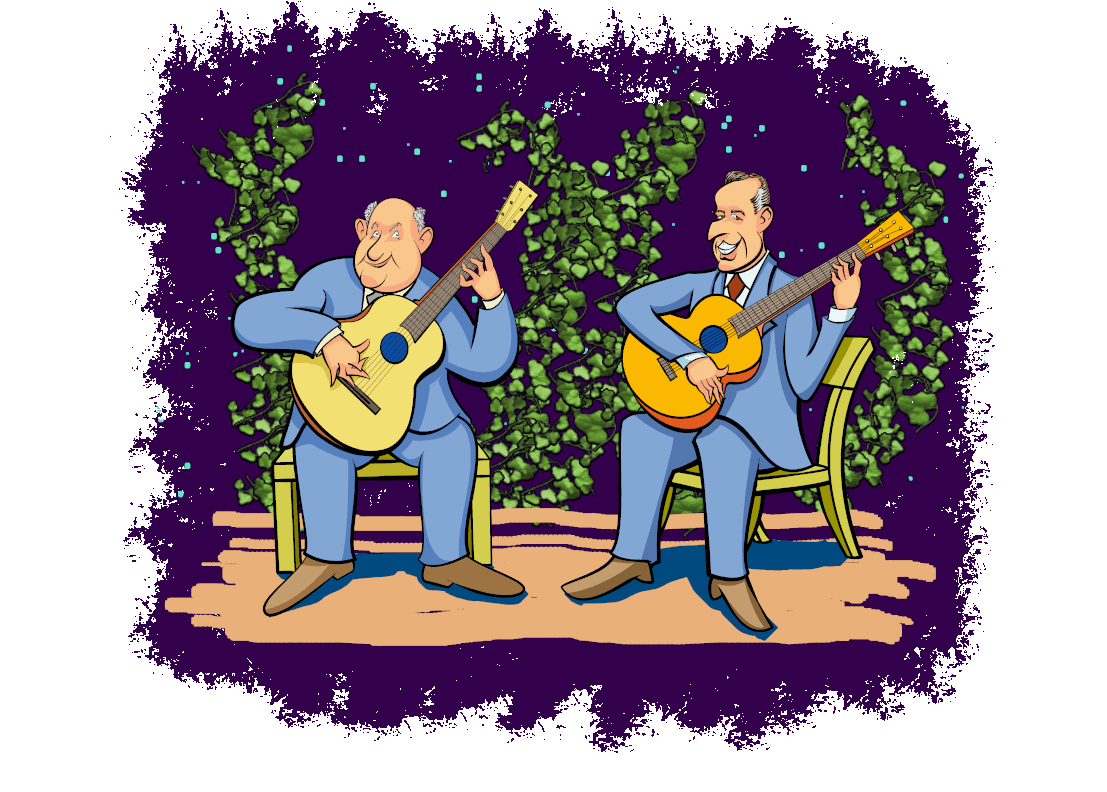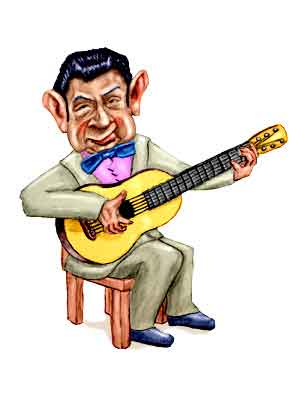Estamos felices de presentarles
Los Dos Montoyas
Tio y Sobrino

(Click on the image to zoom in.)
[Carlos] Montoya plays marvelously - no question about that. But the style of the music is very limited indeed, and one piece sounds very much like another.
Perhaps if one is well acquainted with the style, the music conjures visions of movement that are as real as reality.
But if one is not, one man in a business suit is a poor substitute. Even when that one man is as gifted and dexterous as Carlos Montoya.
- Concert Review, 1961.
You will read that Carlos Montoya was the first major flamenco guitarist to embark on a solo and concert career rather than just providing music for the dancers. And yes, with the advent of the Second World War, Carlos immigrated to the United States and performed exclusively as a solo artist. He certainly became the most famous flamenco player in the United States from the late 1940's until his death in 1993.
But a surprise to his American fans is that scholars of the Flamenco art do not rank Carlos as one of the foremost players. One major guitar reference work - which covers the entire history of the instrument from ancient to modern times - devotes an entire chapter to the flamenco guitar but only has a sentence or two about Carlos and then written in a rather dismissive manner.1
Footnote
The full review of Carlos's performance cited above was written in 1961 and shows the rather mixed nature of a critic's reception:
Guitarist Montoya Lacks Dance Assist
by DONALD MINTZ
Contributing Critic
Carlos Montoya. Flamenco guitarist. At Lisner Auditorium. Program: La Macarena, Monterde; Sacromonte, Turing; Excerpts from Zarzuelas by Chueca and Breton; Traditional Flamenco music arranged by Montoya. New works in Flamenco style by Montoya.
And what exactly is Flamenco? The Harvard Dictionary defines it as "the 'gypsy' style of Spanish dance and dance music." Note that "gypsy" is put in quotes.
As far as American audiences are concerned. Carlos Montoya, who played at the Lisner Auditorium last light, is the foremost Flamenco guitarist. Montoya appeared alone, without dancers and without other instrumentalists. But in the definition just quoted, dance comes first and music second. And that, I think was the trouble with the evening.
Montoya plays marvelously - no question about that. But the style of the music is very limited indeed, and one piece sounds very much like another. I was able to hear two thirds of the program, and in that time I think I must have heard one single harmonic progression over a hundred times.
The afficionados [sic] were enthusiastic. Perhaps if one is well acquainted with the style, the music conjures visions of movement that are as real as reality.
But if one is not, one man in a business suit is a poor substitute. Even when that one man is as gifted and dexterous as Carlos Montoya.
On the other hand, Carlos's uncle, Ramón Montoya, has long been held at the highest levels of flamenco playing and is sometimes called the single most important flamenco guitarist in history. And he did play solo concerts well before his nephew launched his career, even though Ramón died in 1949. Fortunately he left a number of recordings many of which have been reissued as long playing albums.
It may be tempting to ascribe the disdain that critics expressed toward Carlos to sour grapes as nothing arouses indignation and criticism more than fame and success. But it is true that Carlos did tend to produce a rough sound heavy with rasgueados which is a playing quite distinct from the crisp clean technique of Ramon and even some of Carlos's own contemporaries such as Agustín Castellón Campos who is known professionally as Sabicas.
Carlos's own fans, though, will point out that his forceful playing simply hearkens back to the days before electrical amplification and when the music had to be heard above the sounds of the palo seco, the clapping of the palmero, and the pasos of the chatitas of the dancers. Carlos, they say, is giving us the authentic sound of the flamenco guitar.
So there.
Of course, there has been much written about the Andalusian art of Flamenco, an art that involves much more than just the playing of the guitar. To read a little about that venerable artform - with references for further reading - you can just click here.
References and Further Reading
Guitars: Music, History, Construction, and Players from the Renaissance to Rock, Tom and Mary Anne Evans, Paddington Press, Grosset & Dunlap, 1977.
"Guitarist Montoya Lack Dance Assist", Donald Mintz, The [Washington, D. C.] Sunday Star, October 15, 1961, p. B6.
"Carlos Montooya Discography", Discogs.
"Ramón Montoya Discography", Discogs.
